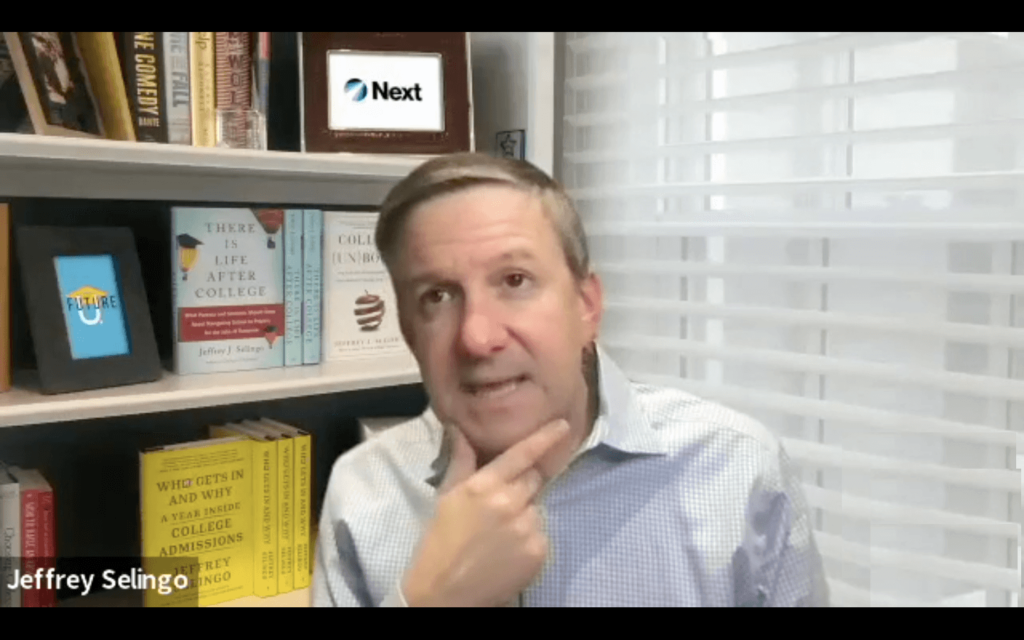Kat Barber ‘23 | Elizabeth Boruff ‘23
Jeffrey Selingo — professor and journalist — has given presentations about the current college admissions process to the EA community, including faculty, parents, and students. The information discussed in those presentations was based off of Selingo’s recent book, Who Gets In and Why: A Year Inside College Admissions.
Selingo engaged in deep research on the college admissions process, providing him the content for his book and lectures. He has “been in and around colleges and universities for more than 25 years,” according to his presentation. Selingo was given special permission to closely observe the admissions processes at three colleges and universities: Emory University, the University of Washington, and Davidson College.

Photo courtesy of Gianna Trala ‘23
Pepper Claytor ‘23 enjoyed Selingo’s presentation, noting, “It was nice to hear from someone who has actually sat in the rooms of these admissions officers, deciding if these students are accepted into these schools.”
In addition to those colleges, Selingo followed select high school seniors throughout their own admissions processes. He also consulted with high school parents, high school college counselors, college rankers, and the College Board.
The EA college counseling office reached out to Selingo, asking him to speak to the EA community about his work and discoveries. Laura Greico, Associate Director of College Counseling, describes the process, saying, “Mrs. Crum, Director of College Counseling, spearheaded the whole thing. We thought about who are some really trusted resources that we know on a national level, and she made the ask.”
In his presentations, Selingo’s main goal was to establish that the college admissions process is not as daunting as it may seem. He said, “I want to start out with a reality check here because the average acceptance rate of an American college today in 2022 is around 60%, which means most colleges accept most students who apply. When we’re talking about how hard it is to get into college, what we’re really talking about is a very small subset of institutions out there.”
Riley Thibodeau ‘23 was shocked by this statistic when she heard it. She comments, “When he said that the average acceptance rate was about 60% or something, I was so surprised. I feel like when we talk about college admissions, acceptance rates are always so much less than that. I think that there’s a lot of stress in the student body about incredibly low acceptance rates, but that stat proves that not every school has such a low acceptance rate.”
He addressed the ongoing worry about success after college, stating, “We’re worried about our kids ending up on the right side of the economic divide. Because of that, we think we have to send them to a brand name college, the one that everybody talks about. We believe that there are only about 20 of those in the whole country, even though there are thousands of colleges out there. We keep thinking that we have to send them to one of those schools in order for them to have success in life.”
Grieco appreciated his focus on having an open mind during the college process. She comments, “One of the things we were really excited to hear was when he was laying out the landscape: how US news and world report rankings are driving all these people to the same schools but not for the right reasons. The idea of having students think really broadly about their college search is a message that we preach all the time, so it was great to have someone else underscore that.”
Selingo also explained what colleges are looking for in an application. He said, “What matters most is your high school transcript. They’re going to look at the courses you took and the grades you got, and for the most part, you have control over that. There’s only so many things you can control in the application, and one of them is, those courses you’ve taken.”
He believes that the college admissions process starts at the beginning of high school, during course selection. He said, “There’s so much anxiety we have over the application over our junior and senior year of high school. The thing is, half of your application is baked by then, meaning it’s the courses you took freshman and sophomore year, and the grades you got. Thinking about those things earlier on is critically important.”
Michelle Jiang ‘24 says, “His talk made me think about the courses I’m taking, especially the ones that aren’t included in the core classes. With course selection coming up, I’m really thinking about the classes that I want to take. I think that EA offers a lot of choice when it comes to classes, but at the same time, it’s difficult to choose between them.”
After the transcript, Selingo believes that colleges are “going to look at things like teacher recommendations and extracurricular activities. Colleges are trying to build a community of students. They don’t want every captain of teams or every president of every club. They want a mixture of students, both leaders and members in many cases. They want students who have done a bunch of different activities, and students who have gone deep in some activities. Stop guessing what people on the other side of the desk want. Instead do what makes you happy and what is your passion in high school.”
Grieco notes, “We would hope our students hear that message: There’s no formula.” Mariana Ramirez, Associate Director of College Counseling, agrees, saying, “Those are probably the biggest takeaways: there’s no formula; do what you love; do what makes you happy; and build a schedule that’s going to work for you.”